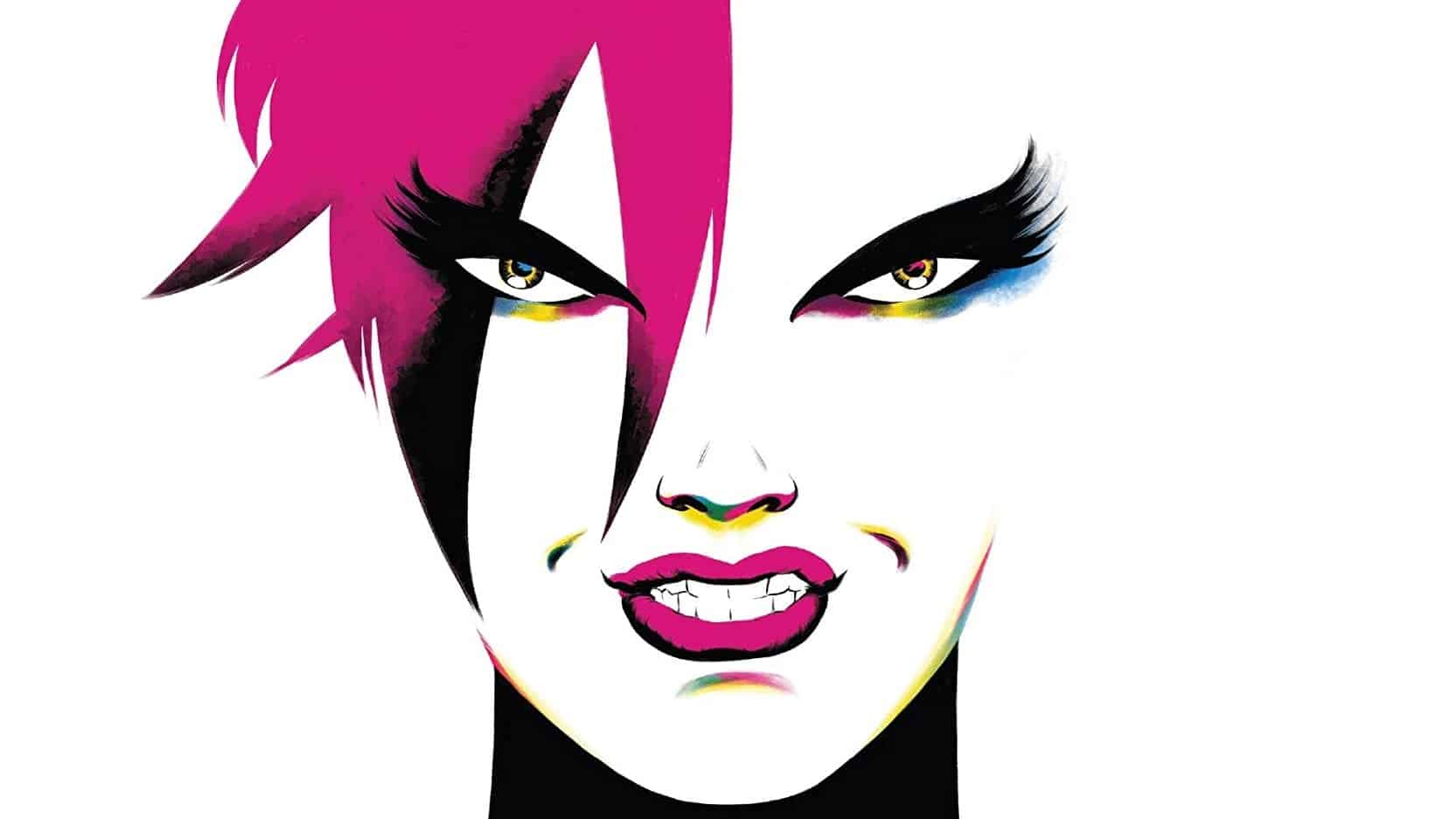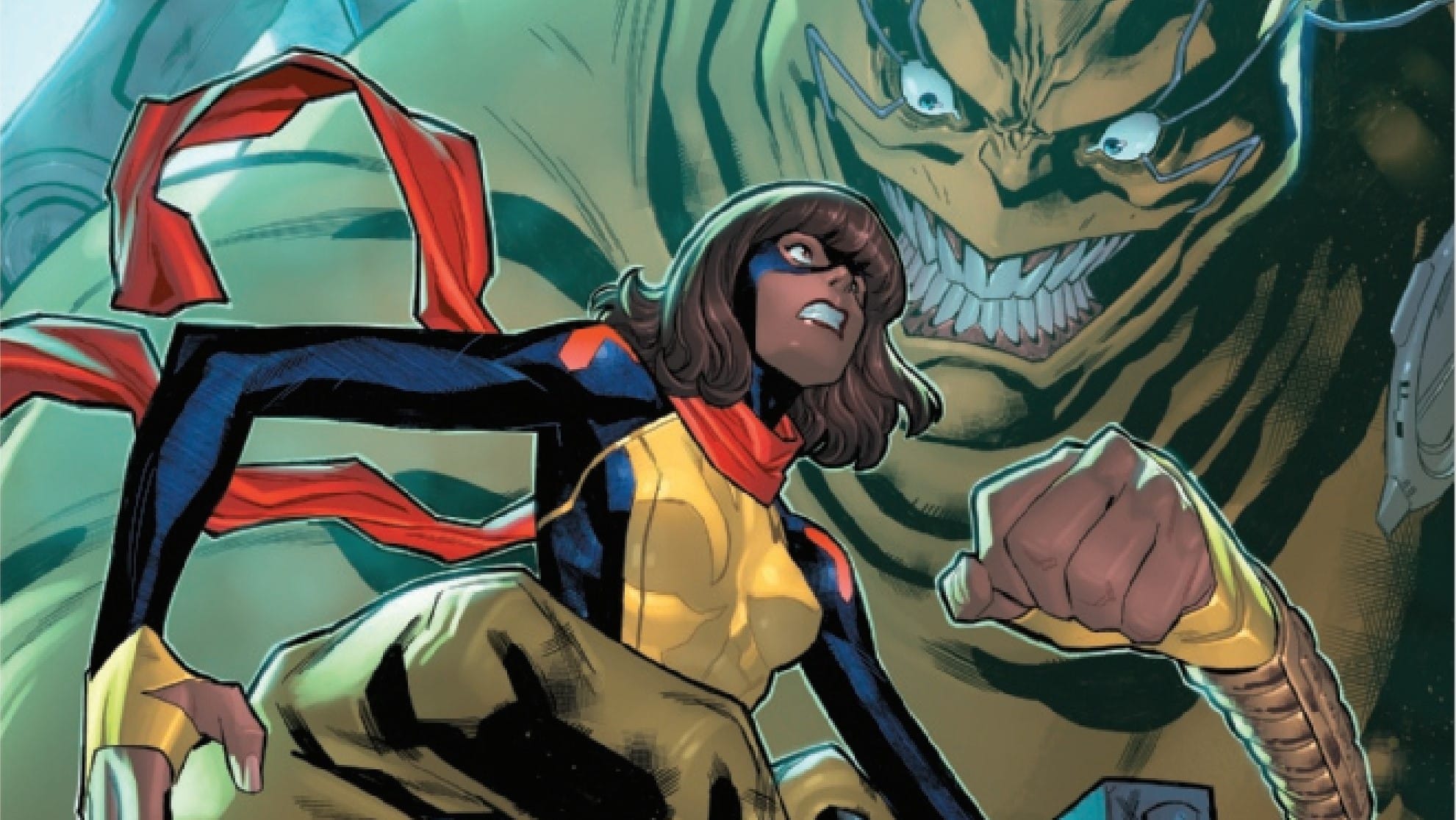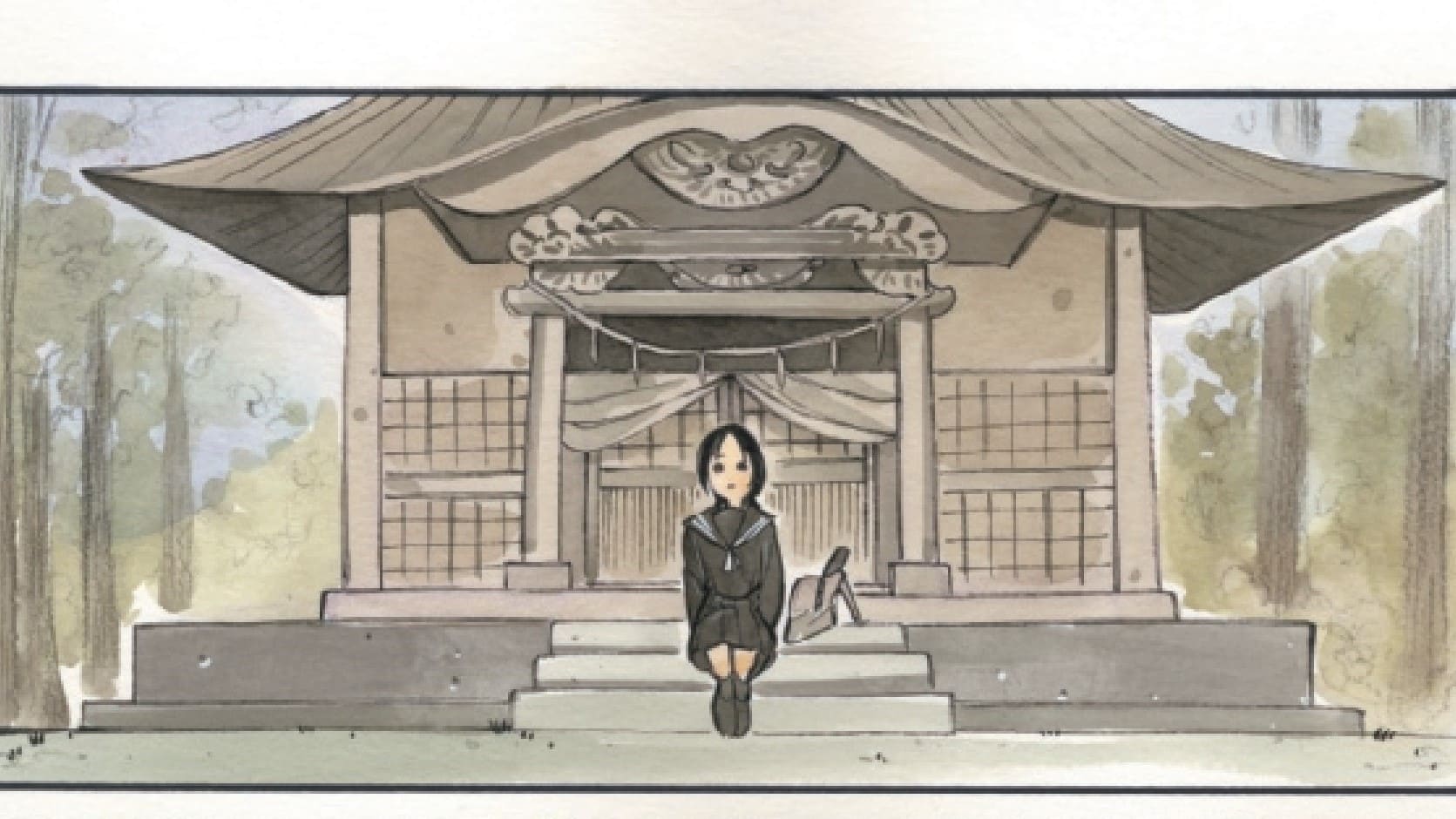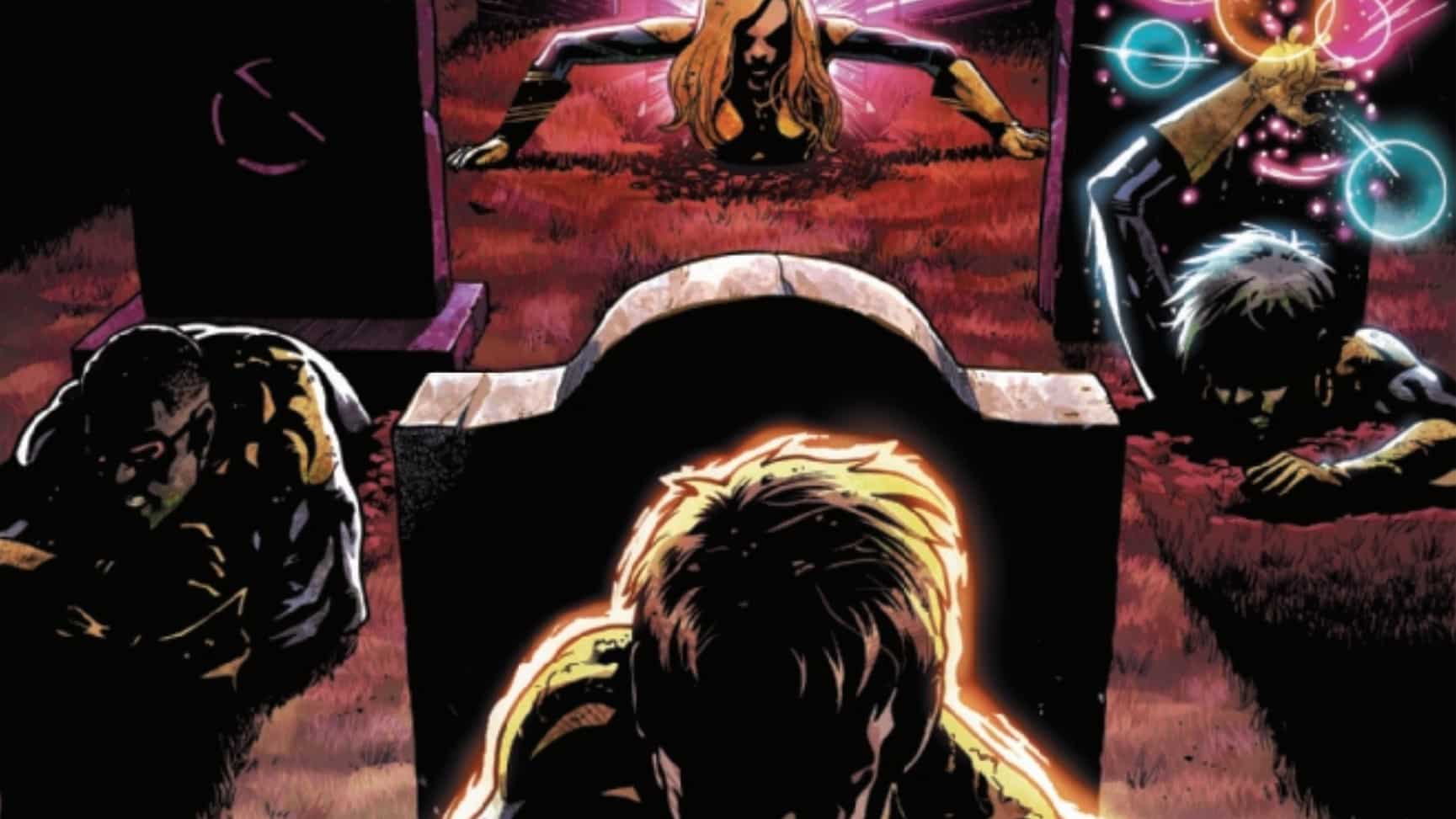Taaia, possessed by the Phoenix Force, turns up the heat as the Defenders make their way through the White Hot Room in Defenders Beyond #3! As told by Al Ewing and Javier Rodríguez, with letters by Joe Caramagna.
Karen Charm: Just when I think it’s going to be a brisk autumn, the Phoenix shows up and melt all my pumpkins. I can barely see my keyboard from all the sweat in my eyes, which means we’ve made it to the White Hot Room. I continue to be delighted and surprised by this comic series and I’m looking forward to getting into it again with you, Mark. It is really you, right Mark?
Mark Turetsky: The only me that ever was! Where I live, we’ve been hitting 100 degree days as late as last week. So, my house has been the nice, cooled room away from the white hot outside, if that makes any sense.
Color Separation

Karen: To read Defenders Beyond is to be on the lookout for narrative uses of symbolic color theory. We’ve seen Rodríguez employ CMYK in increasingly interesting ways, but this issue might be my favorite yet. It starts right on the title page, with the bright yellow Phoenix raptor overlooking some pleasing cyan, magenta, white, and black typography (spelling Tiphareth, naturally). Mark, I think you were the one who called out that the white of the page would come into play here. We have the text “I am the room where the Phoenix is made” hovering in the negative space, so I think you nailed it.
Mark: Right? We can read it as a caption or more likely a psychic emantation, written over the blank white page, or we can read it as the page itself speaking to us, telling us it is the White Hot Room. Crucially, we don’t see a tail leading to the phoenix we see on the page, so I think it more likely the page is speaking to us directly, and so when we see the dialogue on the next page, “and I am the Phoenix,” it’s coming from the Phoenix. Or, both are saying both things: “I am not the Phoenix, and I am the Phoenix.” It’s either and it’s both. It also continues Taaia/Phoenix’s dialogue from the cover, “I am Phoenix.” So, “I am Phoenix, and I am not the Phoenix […] and I am the Phoenix.” I have to wonder about omitting the word “the” on the cover’s version of this dialogue. Is Phoenix a name? Is it a title? It’s both, it’s either.
Last month I briefly touched on the White Hot Room being Tiferet (here spelled as “Tiphareth,” both are inaccurate transliterations of תִּפְאֶרֶת), how it sits in the middle of the Tree of Life, how it’s a balancing force, like the sun in the center of the solar system. And Ewing and Rodríguez just go all in on that imagery. The themes of balance, of the fires of creation. How different forces are at work, such as compassion (Chesed) and severity (Gevurah). And putting Tigra in a dark cave with a bright fire casting shadows on the walls has to be a conscious allusion to Plato’s cave allegory. How our senses present us a wholly subjective, warped impression of the world, where we can’t know the ultimate Truth. But this is the White Hot Room, as Taaia puts it, “where existence meets ‘the real deal’!!”
Phoenix/Taaia refers to Blue Marvel throughout the issue as “Adam Kadmon,” which means, more or less, Primordial Adam. This is different from Adam, the first human in the Torah, who is Adam Ha’Rishon (Adam who is The First). Adam Kadmon isn’t so much human as humanity, a potential wherein is contained all possibility for a human to be. As a brief aside, Adam isn’t just a name, it’s also the Hebrew word for dirt or earth, from which humanity is made in the Torah. Here in the White Hot Room, Blue Marvel is Kadmon, though. He’s not just living antimatter, he’s living potential.
He also encounters a mysterious construction worker, whom Jean Grey met back in Classic X-Men #43. In the Jean Grey story, the construction worker is Death itself. Here, Adam divines a slightly more nuanced identity for the construction worker: he’s Death, but he’s also God, he’s creation, he’s balance. Incidentally, when he appears in Classic X-Men, he doesn’t have a mustache or sunglasses. Here, he’s got both. The sunglasses are reminiscent of Stan Lee’s eyeglasses, and the mustache, well, that’s also pretty Lee.
Personally, I think it’s an allusion to Waid/Wieringo’s Fantastic Four #511, wherein the family meets God, and he looks an awful lot like Jack Kirby sitting at his drawing table. God curiously makes mention of his collaborator. Is this Stan Lee-looking construction worker here to close that circle on a comic from 2004? I personally think so. Not to mention, he refers to building the new on the old, and having to keep to the schedule (they’ve gotta keep putting out new comics every Wednesday, baby!).
Karen: I hadn’t made the Stan Lee connection, but those do feel like significant details to add. It’s a fascinating take on the Classic X-Men story which has never really “fit” neatly within anything else we’ve seen of the Phoenix before or since, I think (though more in line with how Death appears to Dani Moonstar in New Mutants, something I think Ewing is also evoking here).
Mark: And some of the language choices here are really interesting. Back in that Classic X-Men story, Death says, “I am that I am,” which is an allusion to the phrase that the burning bush speaks to Moses in Shemot (Exodus), הְיֶה אֲשֶׁר אֶהְיֶה. It can be translated as “I am that I am,” but here in Defenders Beyond, Ewing translates it as “I am as I am.” No translation into English can be quite right, but modern English Judaism prefers “I will be what I will be.” Incidentally, the Tetragrammaton, the holiest name for God (roughly “Yahweh”), might be a conjugation of the Hebrew verb to be, making God “That Which Is.” Anyway, Ewing here very deliberately puts the Phoenix’s “the only ‘me’ that ever was” in correlation to the construction worker’s “I am as I am.”
Karen: Stan Lee, for his part, can really be seen as “The Word” of the generative force of the Marvel Universe. Both in terms of his capacity as scripter supreme vis a vis Kirby, but also as Marvel’s evangelistic figurehead for longer than I’ve been alive. I do think it’s funny to be having the conversation in this issue, since the Phoenix is so Claremont, but it is what it is.
Mark: Claremont has a mustache (well, more of a Van Dyke) and glasses too, so he’s another candidate!
Bringing a Blender to a Fire Fight

Mark: The sections dealing with America in the desert and Loki and the Beyonder in the frozen wastes leave me the most, well, hot and cold in this issue. What I enjoy most about them are the color choices that Rodríguez uses here. The America sequence uses orange highlights and violet shadows, while Loki and the Beyonder are depicted with azure highlights and rose shadows. I’m using such obscure color names because they sit between our primary RGB and CMY color spaces, with orange sitting between red and yellow, violet between magenta and blue, azure between cyan and blue and rose between red and magenta. It’s an interesting color space for these stories to take place in, neither one thing nor another, but a mix of the two. A balance (there’s that theme again!).
Karen: I was taking them to be close enough to the base CMYK colors to count, but you’re right. Most of these scenes have a purple color hold rather than the standard black line, and we get some green later on in the issue. It’s interesting to me how the desert and tundra scene work as opposites. On the one pole, we have America as “paramedic for the multiverse,” a role that Phoenix is sympathetic with at the very least. On the other, Loki is a glitch, a disruption to the balance of all things. Ewing is calling back to Grant Morrison’s additions to the Phoenix mythos, taking it a step further with this whole “medicinal” angle. Of all the visual allusions in this comic, the most arresting for me is the disembodied mouth of Taaia/Phoenix calling out Loki. It gives very much Rocky Horror Picture Show but also a specific Lifesavers candy ad that I distinctly running in so many comics in the mid-to-late 90s but I can’t seem to find anywhere now. Visceral.
I’m not sure how successful these scenes are at adding to or consolidating all the Phoenix stuff, but it does give us the opportunity to sympathize with Loki. Up until this point, they’ve kind of been the Bugs Bunny of the book, and I appreciate the moment to show some of their humanity, even if it comes a little out of nowhere. In any case, we have a new Bugs Bunny in the book, that being the Beyonder.
Mark: To me, The Beyonder here represents the nuts and bolts of a wholly material world. He’s making smoothies by creating a blender and fruit not from abstract ideas of what “blender,” “fruit” and “smoothie” are, but “forging the base quarks” to get that work done. Loki here, in their capacity as the deity of stories, is almost the opposite: the structure Loki deals with isn’t the base stuff of the material world, but structures of narrative. It’s in contrast to the wholly materialist outlook that The Beyonder is dealing in. The stories are where we find (or assign!) meaning in things. When I mention a blender, I can just say “a blender” and you, the person I’m talking to, don’t need to worry about the base quarks that it’s made of. Again, contrast and balance.
Karen: The blender is a nice metaphor for the Defenders in general. It’s also handy in a scrap.
Every superhero comic must have a fight scene, and here it is, as the Phoenix just starts to attack everyone. I do like how the creative team conveys the Phoenix’s omnipresent nature, picking a fight with Loki that turns into a fight with Blue Marvel simultaneously on the next page. Rodríguez draws Phoenix/Taaia looming all over every page, surrounding the panels and defying being held down to one moment at a time. The fight may be a quota-filler, but it’s an entertaining one, both Ewing and Rodríguez bringing in fun ideas. The best moment is when the Beyonder gets Phoenix’s attention, and when asked what he’ll do with it – ”well, mostly keep it away from Loki!” who opens the door for America to lay the smack down.
The Defenders are able to hold their own, mostly because America brought the Eternity Mask and Beyonder brought his blender, but the Phoenix Force doesn’t go down easily.
Mark: Look, plenty of people don’t like Loki, but they’re not going to sick back and let them be pruned from the Tree of Life!
Afraid of the Dark

Karen: I am so glad that I have been reading through Al Ewing’s Marvel work this year. It was clear, reading Mighty Avengers, that Ewing found a lot of grist in the character of White Tiger, human avatar of the Tiger God. This extremely powerful and vicious entity represents mankind’s most primal fear, that which can not be seen, just outside beyond the fire light. The basic explanation of the Tiger God is repeated so many times in that run that I started to recall it by rote earlier in the issue, but even still I didn’t see this coming. Finally, it makes sense why Tigra is here (not that I needed a reason, of course).
Mark: This was a great reveal, a counterbalance to the Phoenix Force. The image of the firelight is a rich one, isn’t it? The traditional concept is that mankind creates fire, so they can keep predators away at night, and within the safe space created by the fire, they sit around and tell stories. And outside that safe circle roams the tiger. Now, I can’t think of an image of a fire and a tiger without considering William Blake’s haunting poem/print, The Tyger.

Is the “fearful symmetry” echoed in this issue’s “balance?” Maybe. If that’s a bit too heavy for you, here’s R.E. Parrish’s comic about it, which also provides a pretty concise analysis of the poem.

Karen: See, comics always make things easy to understand. Tigra’s big moment is the highlight of the issue for sure. Everything Rodríguez draws from here on out is simply outstanding. Tigra jumping through the fire while shouting “I dance through flames – I eat birds – and I see just fine in the dark!” can be found in the dictionary under “chef kiss.” The Tiger God itself is so stylistic and distinctive – as it tussles with the Phoenix raptor, finally separated from Taaia, both creatures become more than the simple animals they represent. The Phoenix has been set in opposition to Galactus in the past, but I think I like this rivalry a bit more, it feels a bit more “apples to apples.”
Mark: As it happens, I’ve just been reading through the Claremont era of X-Men comics, and Tigra’s trash talk is very reminiscent of Uncanny X-Men #155, where the X-Men go to Avengers mansion and Tigra is the only one around, so they team up against Deathbird. As they fight, Tigra says, “I’m your basic cat by nature – and you’ll never guess what we do to canaries.” So yeah, if it’s cats vs. birds, I’m betting on the cats. And Rodríguez’ Tiger God is gorgeous! I think its design owes a lot to a Japanese contemporary of Blake’s, Kishi Ganku.

Compare this to Blake’s tiger, which, while anatomically closer to the real thing, doesn’t convey the fluid motion of the big cat. It’s also doubtful either artist ever actually saw a tiger. Ganku’s tiger is modeled on a cat (look at the eyes!) while Blake may have seen a tiger that was in captivity at the Tower of London, or more likely saw drawings and paintings of that tiger.
Karen: This is also where we start blending the colors together as the Defenders are once again united against a field of orange, green, and purple. The force of this battle is too much for them to stay on their feet, and they tumble out of the White Hot Room into… the Abyss. Now the Phoenix has been invoking the Abyss throughout this issue, but is there any history for this concept in the Marvel cosmology?
Mark: Not that I’m aware of, but there’s another structure at play here that we’ve been largely ignoring in our reviews, and that’s the narrative structure of the Hero’s Journey (mentioned toward the end of this issue by Taaia). Issue #2 dealt, I believe, with the Crossing of the First Threshold; the heroes have left their world and ventured into a new and bold sphere of adventure and power. This issue is the Belly of the Whale, a place of rebirth, metamorphosis. The Abyss is a major component of the Hero’s Journey, where the hero confronts their (metaphorical) father, or some other (usually, but not always) male figure. It’s the hero’s confrontation with the person or thing who holds the most power in their life (think Luke Skywalker and Darth Vader in Cloud City, and Luke falls into the, you guessed it, abyss).
On the Kabbalistic Tree of Life, the Abyss likely refers to Da’at (“Knowledge”). Depending on whom you ask, Da’at either is or isn’t a sefira. It most properly isn’t one, it’s a point where all sefirot are united as one, but it’s basically an empty space (an abyss!) on the Tree of Life.
Karen: Whatever the Abyss is, it looks great. There are all kinds of funky growths/sculptures that call to mind microscopic forms and the color scheme is personally appealing, a particular mix of black, gray, and ivory. I just can’t get over how great the art is for this series. But yes, look, it’s Glorian the Shaper of Dreams! I know nothing about this character beyond that time he harassed Generation X when they were lost at sea, and he looked quite different from this. Also, there seems to be something quite wrong with him… he looks kind of hole-y. Once again, my interest is piqued for next issue!
Mark: I know very little of Glorian as well, though he showed up in Allred/Slott’s Silver Surfer series during the Secret Wars tie-in, and attempted to help the Surfer and Dawn re-create the universe after it was destroyed (it didn’t end up working). If the cover preview image, with alternate versions of the Defenders, is anything to go by, we’re going to be dealing in the realm of Eternity’s one true love, The Queen of Nevers, who lives in the realm of Couldn’t-Be Shouldn’t-Be (or, as it’s called here, The Kingdom of Never).
Karen: Ooooh I would be very much on board for that! Even if this series is nothing more than a magical Mystery tour, it’s well worth the price of admission. One effect of reading so many Ewing comics in a short amount of time is I’ve started to notice an evenness to them. There’s a consistent pleasant quality that doesn’t shake you up too much, for better or worse, and it largely depends on who the artist is whether or not you’re going to get really excited. That’s not something to worry about with Rodríguez on board, but I do think there’s a lot riding on what comes next in terms of setting some stakes (also I really want to see some Dominions!).
Mark: Not to get too far ahead of ourselves, but issue #5 will likely deal with Keter, the highest sefira. It is completely incomprehensible to mere mortals like us, above our earthly intellects. And, following the Hero’s Journey, our heroes will end up returning to their lives, and Earth, with great boons for the world, either magical or intellectual knowledge, and perhaps most importantly, will learn to live in the present and hold no fear of death. So there’s that to look forward to at least?
Marvelous Musings
- The drawing of America punching Phoenix Taaia in the face is almost certainly a visual nod to Alan Davis’ Captain Britain/Excalibur comics.
- I just like that America punching Gods in the face is the most consistent motif of her character. She’s done it in every issue so far!
- See also the splotchy Sienkiewiczian Phoenix later in the issue.
- A small thing, but America left her jean jacket behind in the desert. Part of her deal in Gillen/McKelvie’s Young Avengers was that she doesn’t wear a uniform, she wears an outfit, but the outfit became so iconic that it became a uniform. Here she’s shedding that past, hopefully moving beyond.
- Am I a little sad that Ewing passed up the chance to work in Rachel Summers and/or iron out all the Necrom stuff here? Maybe a little but that wound scabbed over long ago.
- Phoenix refers to Taaia as “the house where I live,” which in Kabbalah is the concept of Shekhina, literally “Dwelling,” where one can feel the presence of God on Earth/Malkuth. The concept is especially present in Shemot (Exodus) in the form of the Tabernacle; God tells Moses to make a portable house for God to reside in that the Israelites will carry with them back to the Promised Land.
- “I think it really ties the room together!” Loki is a fan of the greatest story ever told, The Big Lebowski.







